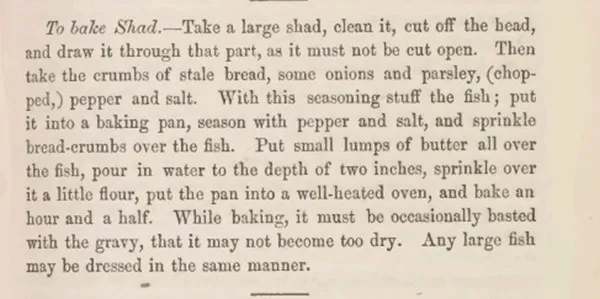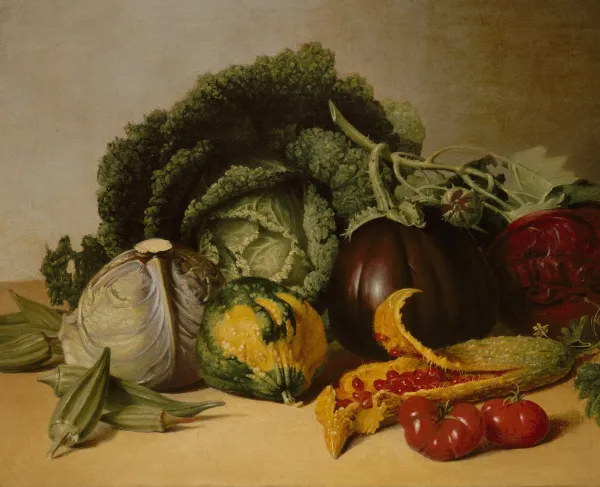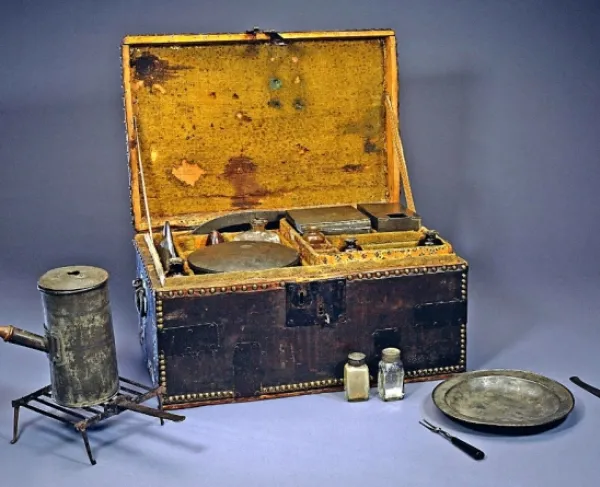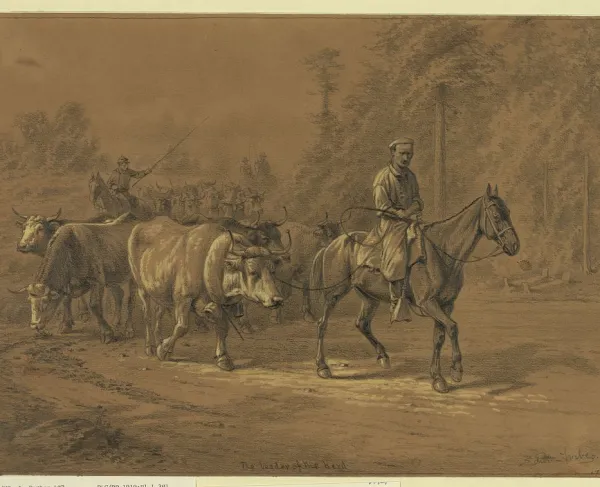
What was it like to dine out during the Civil War? There were no fast-food restaurants, of course, and barely any restaurants at all. With a few exceptions, such as Delmonico’s restaurant in New York City, dining out during the war meant eating in a hotel dining room or at a tavern.
The “gentleman’s ordinary” was the 19th Century term for the men’s dining room. Ladies and children ate in a separate dining room, or at least at a separate table. Women and men generally did not dine together while eating out in order to prevent women of loose morals or prostitutes from infiltrating the dining rooms. Dining out was one of many public endeavors where “respectable” women were segregated from the men.
Although diners by the 1850s could pick and choose among a variety of offerings on the bills of fare for most hotel dining rooms, the meals were often still huge. “To give formality, dignity and order to the occasion, the meal proceeded in a strict and stately progression, with each dish served as a course in itself,” according to An American Feast which described the elements of an elaborate 19th century dinner: “The meal began, typically, with raw oysters and champagne. Then a choice of a white or brown soup and poured sherry was offered. Then fish with Chablis. Next an entree, such as asparagus or sweet corn. Then a slice of roast (with claret and champagne). After that, perhaps a punch to freshen the palate for the courses to follow: some kind of game; salad; cheese pastry or pudding; ices and sweet dishes. Then liqueurs. Then fruit with sherry or claret. Then a selection of nuts, raisins, and sugar plums. Finally, the meal ended with wine, liqueurs, cognac, and cigars.”
Most of the Civil War era-menus shown here come from the University of Houston library, which has a wide selection online. To personalize the menus, we’ve put you in the shoes of a fictional character preparing to have a meal at each dining room. While the characters and their personal stories are make-believe, the information presented is factual.
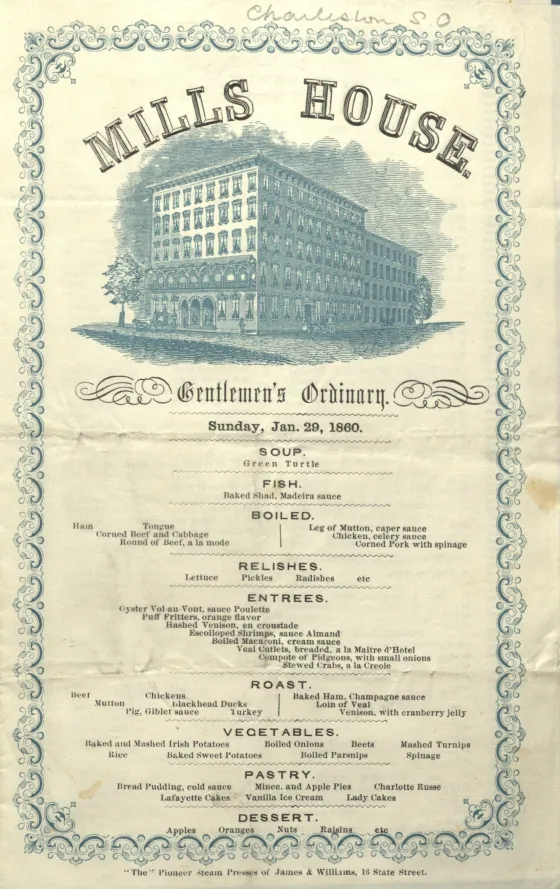
Mills House, Charleston, South Carolina
Sunday, January 29, 1860
As you descend the grand marble staircase and settle into your comfortable chair in the elegant dining room of the Mills House on Sunday, January 29, 1860, you take satisfaction at having reached a station in life that allows you to indulge in some Old South luxury in Charleston, South Carolina. This famous hotel is billed as “the finest hotel south of New York City” and you hope your dinner measures up. Yes, the political scene is becoming ever more tense, but things have settled down since they hung ol’ John Brown last month after his raid at Harpers Ferry. It looks to be business as usual in Dixie in 1860, and indeed it will be, with many of the 3.84 million bales of cotton to be produced this year shipped to Europe from this busy and prosperous Atlantic port. Ah, but what shall it be for dinner today? The green turtle soup sounds sumptuous. Will it be the baked shad with madeira sauce or the “escolloped shrimps, sauce almand”? Or perhaps “compote of Pidgeons, with small onions.” And then your eye spots the corned beef and cabbage, which ignites a yearning for more basic fare. With a fine selection of vegetables, pastries and desserts, including “Lafayette Cake” (gingerbread cake), you’ll probably need to hold the handrail as you climb to your room on the fifth and top floor, especially if you tapped into the hotel’s extensive wine list, which includes a nice selection of fine French wines from New York City’s leading wine merchants. Enjoy the peace of this pleasant winter Sunday in the South because it won’t be around much longer. Come December, South Carolina will secede from the United States. The vote will be taken just blocks away at Institute Hall. The bombardment of Fort Sumter in April 1861 and the start of the war will be a sight to see, but it will be followed by the disastrous Charleston fire of December 1861, which will leave a massive swath of destruction through the heart of the business district, destroying some 600 buildings. It will burn right up to the Mills Hotel and scorch the north side of the building. Guests, including Robert E. Lee, will be forced to flee the flames and brave hotel workers will hang wet blankets from the windows and extinguish falling embers to keep them from igniting the roof. During the 545-day bombardment of Charleston in 1863-65, the Mills House will receive at least 13 direct hits, and will close its doors. But it will survive the war, reopen and continue as a leading Charleston hotel into the 21st century.
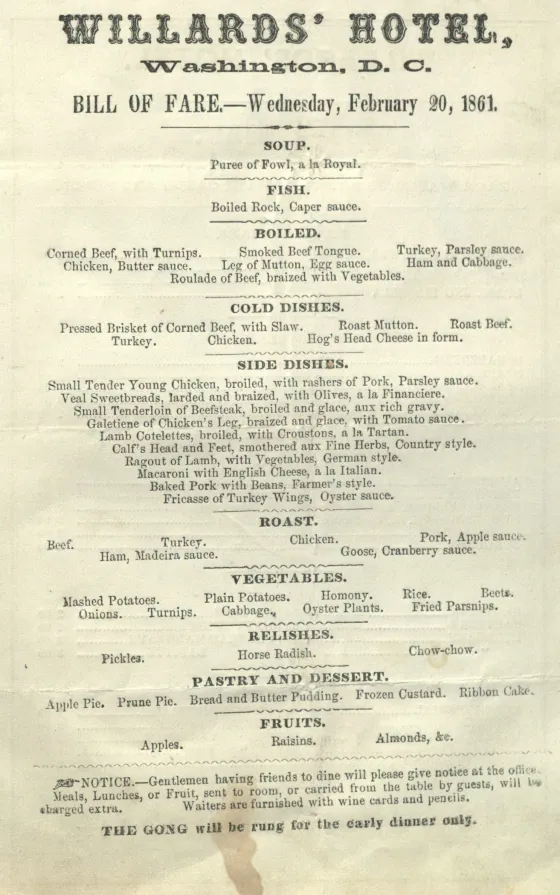
Willards' Hotel, Washington, District of Columbia
Wednesday, February 20, 1861
The City of Washington is alive with anticipation as you take your seat in the dining room at the famous Willards’ Hotel on Pennsylvania Avenue on Wednesday, February 20, 1861, answering the gong that sounded for early dinner. Willards’ is Washington’s most important meeting place, and much of the work of government is said to be conducted in its rooms, hallways and lounges. The chatter on this day is about Abraham Lincoln, the untested but dynamic former Congressman from Illinois, who is on his way to Washington to be sworn in as the 16th president of a deeply divided United States of America. He is in New York City on this day, greeted by an estimated 250,000 well-wishers while making his way to the Astor House.
At Willards’, the extensive bill of fare includes a wide range of “Side Dishes” such as ”Lamb Cotelettes, broiled, with Croustons, a la Tartan,” and “Calf’s Head and Feet, smothered aux Fine Herbs, Country style,” as well as “Baked Pork with Beans, Farmer’s style.” If you desire a meal that will continue to be popular for centuries to come, you ask for “Macaroni with English Cheese, a la Italian.” Vegetable choices include “Homony” and “Fried Parsnips.” For dessert, the “ribbon cake” sounds interesting. Three days hence, on Feb. 23, Lincoln will arrive in Washington and make his way to this very hotel, which will immediately become jammed with visitors and well-wishers. And on March 4, after his inauguration at the Capitol, Lincoln will proceed not to the White House, but to Willards’ for a luncheon that featured mock turtle soup, corned beef and cabbage, parsley potatoes and blackberry pie.
Menu Recreations
To recreate these menus from Mills House and the Willards', American Battlefield Trust staff looked through early and mid-19th Century cookbooks, comparing recipes for the menu fare to find one that seemed to reflect the regional cooking style. The Carolina Housewife (1855 edition) and Miss Beecher's Domestic Receipt Book (1862 edition) are particularly helpful for mid-19th Century recipe comparisons and research. Next, the historic recipes were "translated" for easier cooking in a modern kitchen. Here are a few of the results:
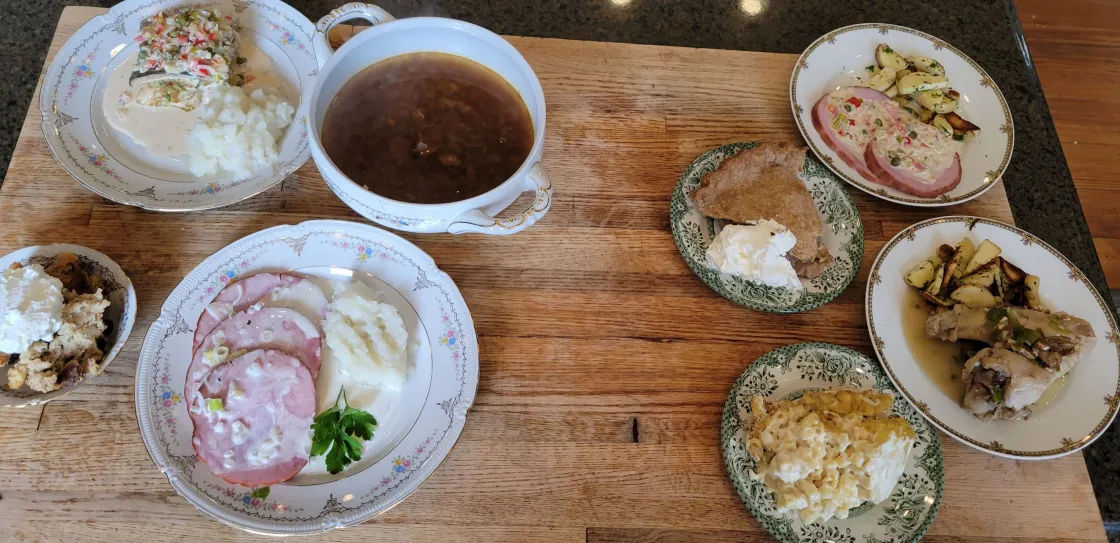
Mills House
- Baked Ham with Champagne sauce
- Mashed Turnips (Miss Beecher's Domestic Receipt Book, recipe below)
- Baked Shad with Madeira Sauce (The Carolina Housewife, recipe below)
- Turtle Soup (The Carolina Housewife, recipe below)
- Bread Pudding (The Carolina Housewife, recipe below)
Willards' Hotel
- Roast Ham with Madeira Sauce
- Fried Parsnips
- Macaroni with English Cheese, a la Italian (The Carolina Housewife, recipe below)
- Turkey Fricassee in Oyster Sauce (The Carolina Housewife, recipe below)
- Apple or prune pie
Mashed Turnips from Miss Beecher's Domestic Receipt Book (page 73)
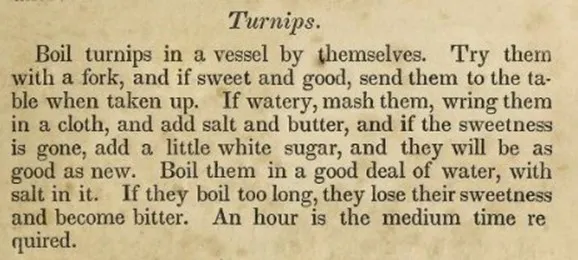
Ingredients:
- 1 pound turnips, peeled and diced large
- 2 to 3 tablespoons butter
- 1 teaspoon sugar
- 1/4 teaspoon freshly ground black pepper
- Salt, to taste
Steps:
- Lightly salt the water and bring to a boil.
- Add cubed turnips and boil for 20-30 minutes or until tender
- Drain turnips; add butter, sugar, and seasonings; mash with a potato masher until fluffy.
- 2 fresh shad fillets, butterflied
- ½ cup unseasoned breadcrumbs
- Onion, finely chopped
- 3 sprigs flat leaf parsley, with stems, finely chopped
- Butter
- Olive oil
- Salt and pepper to taste
Steps:
- Place breadcrumbs, garlic, parsley and butter in bowl. Mix well.
- Add 2 Tablespoons of olive oil onto sheet pan.
- Place shad fillets onto sheet pan. Open both sides of the butterflied shad fillets.
- Spread a thin layer of the breadcrumb mix on the middle section of the fillet.
- Fold the outer sections to enclose the mix. Repeat for second fillet.
- Season with salt and pepper, drizzle with extra butter and place in preheated 375°F oven for 15 minutes, or until cooked through.
- Remove from oven and serve. Add a sauce if preferred.
Turtle Soup from The Carolina Housewife (page 36)
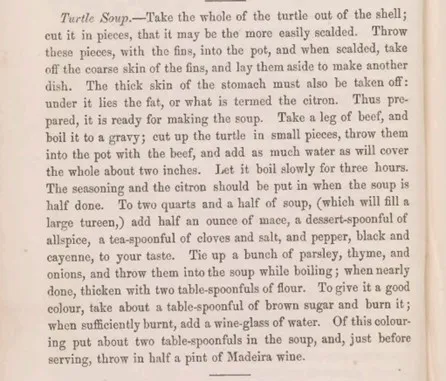
Ingredients:
- Turtle meat (or stew beef)
- Beef broth
- Water
- Citron (or lemon, as a substitute)
- 1 tsp mace
- 1 tsp allspice
- ¼ tsp cloves
- ¼ tsp salt
- ¼ tsp black pepper
- ¼ tsp cayenne pepper
- Parsley
- Thyme
- 2 onions
- 2 Tbsp flour
- 1 cup Madeira wine
Steps:
- Cube the meat; place in pot and cover with beef broth and water for about 4 inches.
- Bring to a gentle boil and simmer for ~45 minutes, adding liquid as needed.
- Add spices and bundle of herbs and onions. Simmer gently for another 30 minutes.
- Dissolve flour in some withdrawn broth, then mix into the soup to thicken.
- Remove from heat and immediately add room temperature Madeira wine, stirring gently.
Bread Pudding from The Carolina Housewife (page 106)

Ingredients:
- 2 cups milk
- 2 eggs, slightly beaten
- ½ cup sugar
- 1 tsp ground cinnamon or nutmeg
- ¼ tsp salt
- 6 cups slightly dry bread cubes (about 6 slices)
- ½ cup raisins (if desired)
Steps:
- Heat oven to 350 F.
- Soak dry bread in the milk.
- Mix eggs, sugar, cinnamon and salt. Stir in bread cubes and raisins. Pour and fold over milk/bread.
- Pour into ungreased 1 1/2-quart casserole.
- Bake uncovered 40 to 45 minutes or until knife inserted 1 inch from edge comes out clean.
- Garnish with whipped cream.
Macaroni a la Sauce Blanche from The Carolina Housewife (page 98)
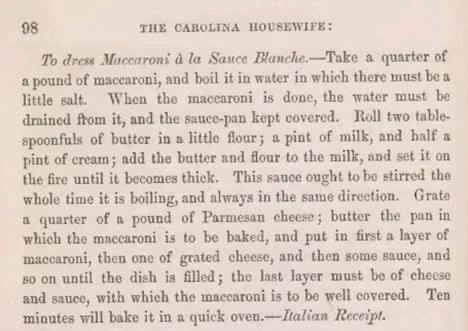
Ingredients:
- 1 cup dry macaroni
- 2 Tbsp butter, plus extra for greasing pans
- 2 Tbsp flour
- 2 cups milk
- 1 cup cream
- 4 oz Parmesan cheese
Steps:
- Preheat oven to 400 F.
- Cook macaroni, drain, and set aside.
- Make a rue with butter, flour, milk.
- Remove from heat and stir in the cream.
- Grate cheese
- Butter the pan
- Layer macaroni, cheese, sauce – finish with sauce and cheese.
- Bake 10-15 minutes
Turkey Fricassee in Oyster Sauce from The Carolina Housewife (pages 69 and 76)
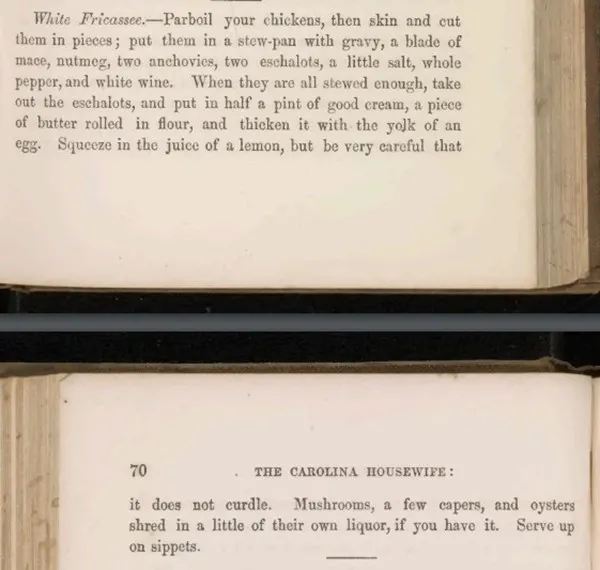
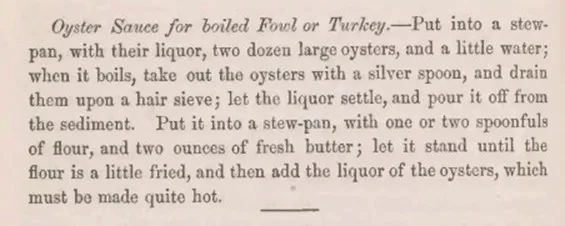
Ingredients:
- 3 cans oysters
- 2 Tbsp flour
- 3 Tbsp butter
- Turkey wings
- ¼ tsp mace
- ¼ tsp nutmeg
- 2 shallots
- ½ tsp salt
- ⅓ tsp black pepper
- ¾ cup white wine
- Mushrooms
Steps:
- Add oysters and liquid to a saucepan with water, bring to a boil and cook for about 5 minutes.
- Remove oysters. Strain and save the liquid.
- Melt butter, add flour and make a rue – adding back some of the oyster liquid to make the sauce. Make it a thick consistency. Set aside.
- In a separate pot, boil turkey until thoroughly cooked.
- Add turkey to the oyster gravy.
- Add spices and bring to a low simmer. Cook for 5 minutes.
- Add shallots, mushrooms, oysters, and white wine. Cook for ~5 minutes.
